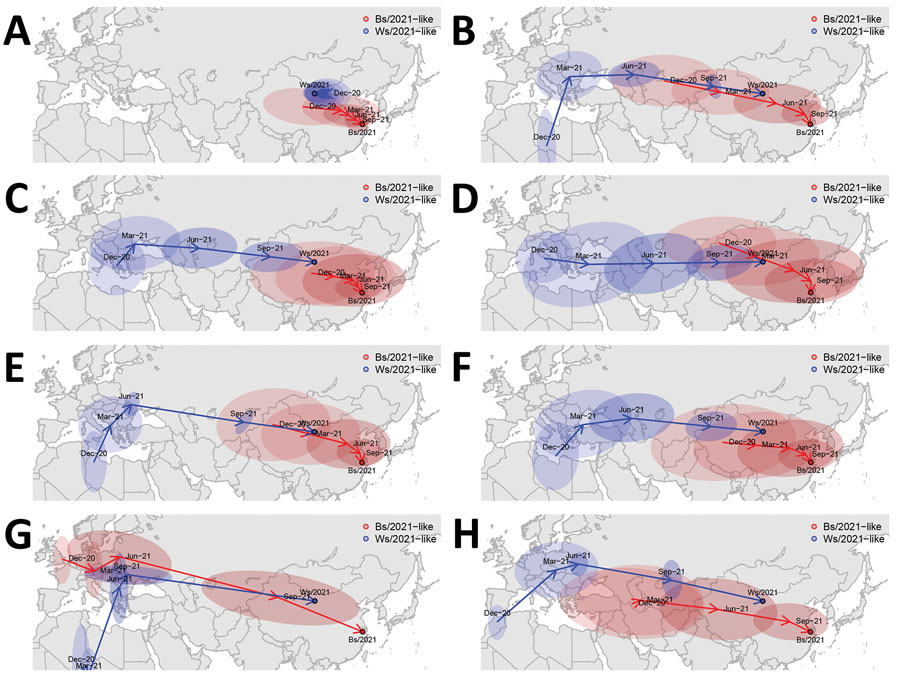Novel Avian Influenza Virus (H5N1) Clade 2.3.4.4b Reassortants in Migratory Birds, China
Jing Yang
1, Chunge Zhang
1, Yue Yuan
1, Ju Sun
1, Lu Lu
1, Honglei Sun, Heting Sun, Dong Chu, Siyuan Qin, Jianjun Chen, Chengbo Zhang, Xiyan Hao, Weifeng Shi, Wenjun Liu, George F. Gao, Paul Digard, Samantha Lycett, and Yuhai Bi

Author affiliations: Institute of Microbiology, Center for Influenza Research and Early-warning (CASCIRE), Chinese Academy of Sciences–The World Academy of Sciences Center of Excellence for Emerging Infectious Diseases, Chinese Academy of Sciences, Beijing, China (J. Yang, Chunge Zhang, J. Sun, W. Liu, G.F. Gao, Y. Bi); University of Chinese Academy of Sciences, Beijing (J. Yang, Chunge Zhang, W. Liu, G.F. Gao, Y. Bi); Shandong First Medical University, Taian, China (Y. Yuan, W. Shi, Y. Bi); Shanxi Agricultural University, Taigu, China (J. Sun, Y. Bi); University of Edinburgh, Edinburgh, UK (L. Lu, P. Digard, S. Lycett); China Agricultural University, Beijing (Honglei Sun); State Forestry and Grassland Administration, Shenyang, China (Heting Sun, D. Chu, S. Qin); Wuhan Institute of Virology, Chinese Academy of Sciences, Wuhan, China (J. Chen); Ordos Forestry and Grassland Development Center, Ordos, China (Chengbo Zhang); Hohhot Center for Disease Control and Prevention, Hohhot, China (X. Hao)
Main Article
Figure 2

Figure 2. Spread patterns of all 8 gene segments of highly pathogenic avian influenza virus (H5N1), Bs/2021-like and Ws/2021-like reassortants, identified in migratory wild birds in China. Virus spread patterns reconstructed for 8 genes. A) polymerase basic 2 gene. B) polymerase basic 1 gene. C) polymerase acidic gene. D) hemagglutinin gene. E) nucleoprotein gene. F) neuraminidase gene. G) matrix gene. H) nonstructural protein gene. Blue indicates spread patterns of Ws/2021-like and red indicates spread patterns of Bs/2021-like H5N1. The spread patterns were adjusted by interpolating the ancestral space-time points by every 3 months from December 2020 through November 2021. Arrows represent the inferred ancestral locations at corresponding interpolated time (at 3-month intervals going back along their inferred transmission routes), and filled ellipses represent the 95% uncertainty of the inferred ancestral locations.
Main Article
Page created: April 17, 2023
Page updated: May 17, 2023
Page reviewed: May 17, 2023
The conclusions, findings, and opinions expressed by authors contributing to this journal do not necessarily reflect the official position of the U.S. Department of Health and Human Services, the Public Health Service, the Centers for Disease Control and Prevention, or the authors' affiliated institutions. Use of trade names is for identification only and does not imply endorsement by any of the groups named above.
